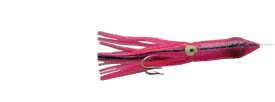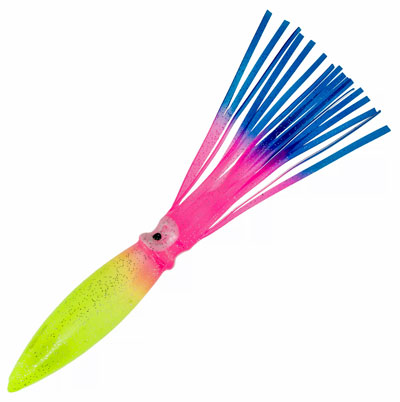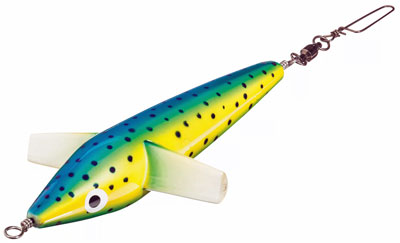- Home
- Fishing Techniques
- Handline Fishing
A Handline Fishing Rig for
Trolling Offshore
Handline fishing can be every bit as effective as fishing with a rod and reel.
Particularly, it's a fishing technique that shouldn't be ignored by offshore sailors, where a properly sorted hand line fishing rig in the right hands will keep the crew well fed.
The operative words in the previous paragraph are 'in the right hands', as there are two distinct opinions as to the value of trolling a line astern when your real intention is to reach your destination without complication.
One has the skipper crowing gleefully about the abundant supply of free fresh protein, and the other complaining bitterly about the additional drag suffered for no appreciable benefit - "Damn thing must have added a day to the passage..."
But it need not be so. A little knowledge and some carefully assembled, but inexpensive, equipment will soon have you hauling good fish over the transom.
A Handline Fishing Rig is Simple, Cheap and Effective
No expensive rod and reel to buy for handline fishing - just a few metres of line, a lure or two and some other bits and pieces. The lure can be a relatively cheap Bulbhead Squid rigged as shown here.
Use a monofilament leader of 150lb to 300lb breaking strain, crimp on a single or double hook (I've used a double here), slide on an egg-shaped lead (sized to fit securely inside the nose of the lure) - and that's it.
The hook should be positioned such that it's just concealed by the lure skirt, so it may be necessary to slide on a few beads between the hook and the sinker to get it positioned 'just so'.
Snug it all up so that the sinker is positioned in the head of the lure and you're ready to your handline fishing rig.
 Bulb squid trolling lure components
Bulb squid trolling lure components Bulb squid trolling lure ready to catch!
Bulb squid trolling lure ready to catch!We mentioned skirting trolling lures earlier. These are very similar to the lures described above except that they have a separate lure head, which generates an attention-grabbing stream of bubbles - the 'smoke trail'.
You'll have to pay a little more for these lures, but if they catch a few more fish ...?
But whether you fish just for the fun of it, or for the culinary
expectation, the whole endeavour is greatly enhanced if a fish is caught
occasionally.
I'm betting you're keen to join the abundant supply club as previously mentioned and set about learning what distinguishes them from the other lot.
Being plain lucky counts for much of course, but there are several things that can be done to improve the odds when using an offshore handline fishing rig. And here they are...
Improving the Odds
The first requirement is to use substantial gear when using a handline fishing rig offshore. A lighter inshore outfit for mackerel, bass and pollack may pick up small fish for a while, but sooner or later a big-un will deprive you of it.
Basic offshore trolling handline fishing rigs should consist of:~
- about 25m of 300lb nylon monofilament line
- a heavy-duty snap swivel connected to the end of it to prevent kinks and twists and to provide an attachment for
- a 3m (10ft) long leader of similarly heavy nylon monofilament, with a reinforced loop at the forward end for easy connection to the afore-mentioned snap, and
- a lure imitating either a baitfish or a squid at the other end.
 Basic trolling handline
Basic trolling handlineThe trolling sinker, as shown here, is optional. That's because it does no harm at all if the lure breaks the surface occasionally
And that's it, you're ready to troll.
Well almost...
A Shock Absorber is a Must for Handline Fishing!
Some means of absorbing the power of your fish's initial bid for freedom is essential - otherwise you run the risk of losing your fish in the first few seconds of it being hooked. It happens like this...
When a big fish grabs hold of a smaller one, it rightly expects it to stop swimming about.
If the smaller one is a lure attached to a 10 tonne boat sailing at 6 knots, then the resultant inertia will be immediately apparent to the predator, and will come as something of a surprise.
Now a tuna can swim at 40 odd knots, and is very likely to do so on finding he has grabbed a small fish with more pulling power than he has. Exit tuna, with or without lure, depending on the strength of your gear - which is why you need a shock absorber for handline fishing!
Winding your handline a few times around an available cockpit winch the 'wrong' way will provide the vital shock absorbency, along with a noise that will alert all in range.
Alternatively you can use a snubber made from a length of bungee cord - essentially a large elastic band between the handline and the boat.
 A snubber is an essential part of an offshore trolling handline
A snubber is an essential part of an offshore trolling handlineThe safety line, made up from a length of 8mm braid rope (or similar) is attached to a cleat or some other strong-point on the boat.
Getting Connected
All knots will reduce the breaking load of your gear to a degree, some much more so than others. Bowlines and other sailors knots aren't suitable for nylon monofilament - they'll slip. But there are a few specialist fishing knots (which you need to know) that won't slip if you tie them correctly.
Use the uni-knot or a crimped connection for joining the mono handline to the snap swivel at the leader connection, a haywire twist for single-strand wire and a crimped connection for plastic-coated multi-strand wire and mono over 80lb breaking strain.
Knots are free, but sadly the crimping route means you're going to have to part with a little of your hard-earned cash.
Leader Line Material
Heavy nylon line as described above would be my choice - you'll need to use crimps to make the connections, as mono line of this diameter is impossible to knot.
But if you're expecting a really toothy critter - barracuda, wahoo, shark or one of their dentally privileged chums - then a wire leader is what you need. There are three types:~
- single strand wire ~ prone to kinking and can only be connected with a haywire twist
- plastic-coated multi-strand wire ~ see comment below
- cable ~ can only be connected with crimps, indestructible but highly visible
I'm not a great fan of using plastic-coated multi-strand wire as it has let me down a couple of times. The only way of making connections in this line is with crimps, but at the point of the bend the nylon tends to fail and allows seawater to get between the wire and the plastic coating.
And as we all know, 'stainless' is a misnomer so the wire soon corrodes and breaks when load is put on it.
I've lost two Rapala lures through this weakness, and at fifteen quid ($25) a throw that's two too many. But it is more flexible and less prone to kinking than single-strand wire, so if you do choose to use it you should check it regularly and replace it often.
Trolling Speed?
Sailing too fast won't be an issue, as pelagic fish of the ocean appear to take more interest in a lure doing six knots more than one swanning around at 3 knots. Even so I normally take my lines in when boat speed reaches 8knots or so, as this speed means I've got the spinnaker up.
Ocean gamefish aren't breaking a sweat at this speed, but dropping the kite at one end of the boat and trying to deal simultaneously with an underwater greyhound at the other can represent more of a challenge than I like to get involved in.
TOP TIP!
Always wear protective gloves when hauling in a fish, or you risk serious injury to your hands. And never, ever wrap the line around your hand. Even if the fish is small, a larger one may grab it, with dire consequences for your hand if you can't immediately let go.
Haul the line in palms down so it would be pulled downwards from your grasp if there's a sudden surge.
Have a knife close to hand to cut the line if necessary. You may hook a fish that's far too powerful or dangerous or you may have entangled some part of yourself in the line.
In this situation the voluntary loss of your most expensive trolling lure is cheap indeed.
How Deep?
Neither should you worry too much getting the lure down deep when you're handline fishing a trolling lure. Most fish are caught within a couple of metres of the surface. If the lure breaks the surface now and again, it's not a problem and seems to attract dorado (aka mahé mahé, or dolphin fish) in particular.
But there are times when you may want to get your lure down to fish that are hanging out deeper. A trolling weight will achieve an extra couple of metres or so, but to get any deeper you'll need a planer...
Attach it to the end of your trolling line, around 10m or so ahead of your lure which means you may have to extend the length of your leader.
A plastic paravane will be no use to you here, the drag of an offshore trolling lure will trip it immediately.
Planers are stainless steel devices which use the hydrodynamic properties of water flow to drive it downwards, much like the inverted wing of an aircraft. The larger the planer and the faster it's towed, the deeper it will get. But they have their limitations - as a general rule expect around 5m of depth for every 10m of handline deployed.
How Far Astern?
Some yachtsmen advocate trailing the lure about 100m astern of the boat. For a boat under power this is probably good advice, but I don't believe it's necessary for a yacht under sail. In fact fish can sometimes be seen shadowing the yacht just aft of the transom - they're clearly attracted to it.
One and half boat lengths astern is a good place to start, dropping the lure a little further astern if you don't get a result.
Improve Your Catch Rate with Two Fishing Handlines!
You really can double your chances by deploying two handlines, one from each quarter. But with two lines out you'll need to keep them apart, either by depth differential or horizontal displacement - or a bit of both. Here are a few ways of achieving this:~
- Use trolling lines of different lengths, making sure that the windward line is the shorter one. This works well on a sailboat due to the effect of leeway, but much less so with a power boat.
- Deploy the lines from different heights. The higher one could be lifted to a quick-release clip on the backstay (or gantry) to allow to be blown off to leeward.
- Use lures of different types, one of which operates at a greater depth than the other. On one handline you could have a simple squid lure or skirted trolling lure as described above. On the second trolling line, a deep-diving plug for example.
- Use a planer or a trolling sinker to get your lure down deeper, remembering to keep it 30ft or so ahead of the lure to avoid spooking the fish. A trolling spoon could be a good lure choice to try on this line.
TOP TIP!
For any trolling lure that operates close to the surface, you should think seriously about a Bird Teaser. So what's a bird teaser?
It's a buoyant fish-like device attached around 3m (10ft) or so ahead of your lure. Clip it on the end of your trolling handline and attach your leader to the snap swivel at the end of the bird. Even more effective is to use a string of bird teasers - a daisy chain...
Its sole purpose is to splash around on the surface,
causing any nearby predator to wonder what all the fuss is about, then
cruise over and take a look.
What he'll believe he's seeing is a small shoal of
baitfish playing around on the surface. One though is in trouble,
straggling off the back of the shoal away from the others - your lure,
the obvious target.
A bird is probably the simplest and most effective way of improving your strike rate when you're handline fishing a trolling lure - they really do make a difference.
Recent Articles
-
Sea Fishing Rods and Reels Must Be Compatible for a Balanced Outfit
Mar 08, 21 08:30 AM
A quality reel fitted to a quality rod doesn't necessarily make it a quality outfit. Your fishing rods and reels have to be properly matched if you're to get the best out of them, and here’s how -
Essential Lure Fishing Tips That All Saltwater Anglers Should Know
Mar 08, 21 04:51 AM
Which single lure fishing tip applies to trolling, jigging, baitcasting, spinning, fly fishing and any other branch of lure fishing? Well, it is the one at the top of this list -
Vital Jig Fishing Tips That You Really Cannot Afford To Miss!
Mar 07, 21 10:20 AM
Essential jig fishing tips to help you select the right lure for successful jig fishing, together with the techniques required to get the most out of your jig fishing outfit


























New! Comments
Have your say about what you've just read! Leave me a comment in the box below.